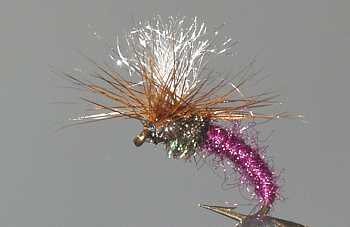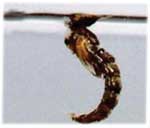Claret Klinkhammer Emerging Nymph
The Klinkhammer fly is a fantistically popular pattern that has caught trout and grayling all over Europe. This floating fly is just like an iceberg: it gives it's best results when 90 per cent of it is under the water.

KLINKHAMMER EMERGER FLY PATTERNS. Hook size 12 14 16 - $US each
Is it my imagination or are long continuous hot summers a thing of the past. What happened to that magical transition from spring into early summer that was filled with mayfly hatches? Some years it feels like winter has extended its grip. In these conditions once the main hatch of mayfly has begun, new adult duns will come off in all but the most dreadful weather. Activity is at its peak late morning into early afternoon though this is sometimes postponed. In cooler weather duns may carry on hatching into late afternoon but quite often there will be no spinner fall. In colder weather even when the egg laying females do get back to the water surface there are so few of them that it is hardly worth the effort.
When weather conditions are bad it is a good idea to look for sheltered water. Look for stretches that are protected from the prevailing wind by a line of trees or a high bank. Casting is easier if the effect of a chilling wind can be reduced. The local micro climate, even if just a degree or two higher, can make a lot of difference when the squall pasts and the sun eventually comes out. The duns will hatch quicker here than on more exposed stretches of the river or lake. When trout are feeding on hatches in warmer weather conditions they are normally swimming just under the water surface, lifting their head when they spot something to eat. In cooler weather they swim lower and take only one or two hatching duns before disappearing deeper. Be observant and mark the position you saw a trout taking food from the surface. Drift your Klinkhammer fly pattern over the same spot. If it is hungry enough it will return to the same spot.

THE IRON BLUE DUN HATCH
The Claret Klinkhammer is a good productive fly to deploy during a hatch of Blue Duns or Iron Blues as a pupae emerger pattern. The Iron Blue mayfly is a very common hatch on many rivers. It is therefore important that fly fishermen stock their fly boxes with flies that can imitate this insects various stages of development. A gold ribbed hare’s ear nymph or pheasant tail nymph are good choices for larval imitations.
The Snipe and Purple soft hackle wet fly, sometimes known as the Dark Snipe, would be my choice if the trout were feeding on subsurface rising Blue Dun pupa. Once the hatch is on then you have two options, an upwing blue dun dry fly imitation or my fly of choice, the Claret Klinkhammer that imitates the blue dun pupa suspended just below the surface film preparing for the dun to crack open the pupa skin and hatch into an adult. Cast your Claret Klinkhammer upstream and let it dead drift over the fish feeding zone. I sometimes tie on two Snipe and Purple soft hackles under my Klinkhammer on droppers three feet apart.
The common name Iron Blue covers two scientific species; the Baetis Niger and the Baetis Muticus. They are hard to visually differentiate. They look the same. Generally speaking the Iron Blue mayflies found on rougher rocky streams will be the Baetis Muticus and those that live on slower rivers with a silt of fine gravel beds will be the Baetis Niger. I do not think it matters much to the trout or grayling that feed on them. I bet they taste the same.
Iron Blue duns hatch mainly between April and June, obviously this varies depending on where you live. For example on the river Ribble, in north west England there are large hatches of Iron Blue Duns in late March, with a second hatch in September to October. Down south on the river Test, where the temperatures are normally warmer, the second hatch continues until mid November. Hatches usually occur early morning and again in the afternoon.
Some fishing reports have observed that the main hatches of Iron Blue duns occur on cold blustery days. This may simply be because spring and Autumn Fall days are often marked by disagreeably cold, downstream winds and not because these upwinged mayflies decide to hatch in numbers when the weather is particularly bad. Some of the largest hatches of iron blue duns I have experienced have been in pleasant spring and warm Autumn Fall days.
Iron Blue duns are small mayflies with a body length of only 5-7mm, excluding the tail. They have a dark gray forked tail and dark dull inky blue gray wings. You do not have to make a close examination of them to make an identification. They are unmistakable as they float downstream with wings held high after hatching from the nymphal stage at the water surface; small, overall blackish or blue black appearance. Rainbow and Brown Trout love them.
When fishing during times of mixed hatches I have seen trout selectively search out the iron blues over the other hatching mayflies. This I found strange as sometimes the other mayfly was larger, like the medium Olives or large Dark Olives and must have represented a bigger meal. As with most upwinged mayflies, the dun leave the wager and fly to thick vegetation away from the river where they moult into the sexually mature Spinner stage.
Mating often occurs away from the water. Iron blue Spinners normally fall to the ground exhausted and die though not all. Some males fall onto the water surface and drown. These have been given the name Jenney Spinner. It is a strange name to give to a male insect but it has been in use for over two hundred years. Look for two long white tails, a brilliant white abdomen tipped with a red-brown or purple-brown, black thorax and transparent wings.
The female Iron Blue spinner, sometimes called the Little Claret Spinner, is similarly distinctive. It has long pale-gray tails, a rich dark red-brown abdomen, black thorax with a similar red-brown markings and transparent red veined wings. She returns to the water to lay her eggs. When she has completed her task she falls onto the water surface exhausted and dies. This can happen in the morning as well as late afternoon. If it happens in sufficient numbers it may evoke a selective feeding response in the Rainbow and Brown Trout.
CUSTOMER'S COMMENT
I was fishing a stretch of the river Inny that was over shadowed by alder trees. The river swings down in a series of riffles and pools. Some of the trees that had been damaged in last winter’s storms had been pulled back from the river bank which allowed light into some sections. These proved to be the most productive, just as you said in your article, it produced its own micro climate. That part of the river was slightly warmer than the other sections. Nymphs started to rise to the surface earlier in that bit. I concentrated casting to those zones using a
Klinkhammer on top a beaded gold ribbed hares ear nymph on point and a pheasant tail as a dropper. All my takes, except one, that day were on the Klinkhammer dry fly pattern
- George Lever, Cardiff
Fly Fishing books

